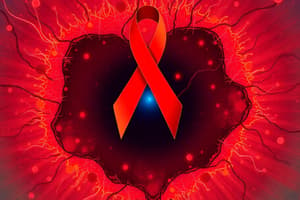Podcast
Questions and Answers
After a needlestick injury involving a patient with unknown blood-borne infections status, what factor would MOST significantly influence the decision to initiate post-exposure prophylaxis?
After a needlestick injury involving a patient with unknown blood-borne infections status, what factor would MOST significantly influence the decision to initiate post-exposure prophylaxis?
- The availability of safety-engineered syringes at the time of the incident.
- The injured healthcare worker's personal history of liver disease.
- The injured healthcare worker's vaccination status for influenza.
- The prevalence of HIV, HCV and HBV in the local community where the injury occurred. (correct)
Which strategy would be MOST effective in preventing blood-borne pathogen transmission from needlestick injuries in a healthcare setting?
Which strategy would be MOST effective in preventing blood-borne pathogen transmission from needlestick injuries in a healthcare setting?
- Providing personal protective equipment (PPE) such as gloves and gowns.
- Mandatory annual training sessions on blood-borne pathogens.
- Using needles with safety features and ensuring proper disposal in designated containers. (correct)
- Routine testing of all patients for HBV, HCV, and HIV.
A healthcare worker sustains a needlestick injury. The source patient is positive for Hepatitis C. What is the approximate risk of the healthcare worker contracting Hepatitis C from this single needlestick incident?
A healthcare worker sustains a needlestick injury. The source patient is positive for Hepatitis C. What is the approximate risk of the healthcare worker contracting Hepatitis C from this single needlestick incident?
- 1-1.5%
- 3% (correct)
- 30%
- 0.3%
A clinic is implementing strategies to reduce the risk of blood-borne pathogen transmission. Which of the following actions would be considered an administrative control?
A clinic is implementing strategies to reduce the risk of blood-borne pathogen transmission. Which of the following actions would be considered an administrative control?
What is the MOST accurate statement regarding the treatment of blood-borne viral infections?
What is the MOST accurate statement regarding the treatment of blood-borne viral infections?
Which of the following factors presents the HIGHEST risk of blood-borne pathogen transmission following a needlestick injury?
Which of the following factors presents the HIGHEST risk of blood-borne pathogen transmission following a needlestick injury?
A nurse is stuck by a contaminated needle after administering an injection to a patient of unknown infectious disease status. What is the FIRST and MOST important action the nurse should take?
A nurse is stuck by a contaminated needle after administering an injection to a patient of unknown infectious disease status. What is the FIRST and MOST important action the nurse should take?
According to the hierarchy of controls, which intervention is MOST effective in preventing sharps injuries in a hospital setting?
According to the hierarchy of controls, which intervention is MOST effective in preventing sharps injuries in a hospital setting?
Which scenario represents an administrative control measure aimed at reducing the risk of blood-borne pathogen exposure in a healthcare setting?
Which scenario represents an administrative control measure aimed at reducing the risk of blood-borne pathogen exposure in a healthcare setting?
Which of the following blood-borne infections has a highly effective vaccine available for pre-exposure prevention?
Which of the following blood-borne infections has a highly effective vaccine available for pre-exposure prevention?
A phlebotomist is accidentally stuck with a used needle while attempting to recap it. Besides reporting the incident and washing the wound, what is the NEXT appropriate step?
A phlebotomist is accidentally stuck with a used needle while attempting to recap it. Besides reporting the incident and washing the wound, what is the NEXT appropriate step?
Which action significantly increases the risk of needlestick injuries among healthcare workers?
Which action significantly increases the risk of needlestick injuries among healthcare workers?
A healthcare professional (HCP) has completed the HBV vaccine series. What is the specific documentation required to confirm they are protected?
A healthcare professional (HCP) has completed the HBV vaccine series. What is the specific documentation required to confirm they are protected?
What is the PRIMARY reason for encouraging the use of safety-engineered devices (SEDs) with needles in healthcare settings?
What is the PRIMARY reason for encouraging the use of safety-engineered devices (SEDs) with needles in healthcare settings?
Approximately what percentage of vaccinated individuals will not develop immunity following two doses of the HBV vaccine?
Approximately what percentage of vaccinated individuals will not develop immunity following two doses of the HBV vaccine?
After a needlestick injury, initial first aid includes allowing the wound to bleed freely. Why is this step important?
After a needlestick injury, initial first aid includes allowing the wound to bleed freely. Why is this step important?
A surgeon cuts themselves with a scalpel during surgery on a patient with known Hepatitis C. After immediate wound care, what is the MOST appropriate next step for the surgeon?
A surgeon cuts themselves with a scalpel during surgery on a patient with known Hepatitis C. After immediate wound care, what is the MOST appropriate next step for the surgeon?
Which factor is LEAST relevant when assessing the risk of infection following a needlestick injury?
Which factor is LEAST relevant when assessing the risk of infection following a needlestick injury?
An individual who does not develop an antibody response after three additional doses of the HBV vaccine is considered:
An individual who does not develop an antibody response after three additional doses of the HBV vaccine is considered:
A healthcare worker experiences a needlestick injury. After washing the wound with soap and water, what is the NEXT appropriate step?
A healthcare worker experiences a needlestick injury. After washing the wound with soap and water, what is the NEXT appropriate step?
What immunological mechanism explains why individuals who have had their Hepatitis B surface antibody (HBsAb) titer drop below 10 IU/mL can still be considered protected?
What immunological mechanism explains why individuals who have had their Hepatitis B surface antibody (HBsAb) titer drop below 10 IU/mL can still be considered protected?
Which component is contained in the Hepatitis B vaccine that triggers an immune response?
Which component is contained in the Hepatitis B vaccine that triggers an immune response?
For whom is the Hepatitis B vaccine publicly funded as a routine immunization?
For whom is the Hepatitis B vaccine publicly funded as a routine immunization?
Following a needlestick injury from a source known to be positive for Hepatitis B, but the exposed individual has previously completed the HBV vaccine series and antibody titre is unknown, what is the MOST appropriate initial post-exposure management?
Following a needlestick injury from a source known to be positive for Hepatitis B, but the exposed individual has previously completed the HBV vaccine series and antibody titre is unknown, what is the MOST appropriate initial post-exposure management?
An individual who sustained a high-risk exposure to HIV has initiated PEP. What duration of treatment is typically recommended?
An individual who sustained a high-risk exposure to HIV has initiated PEP. What duration of treatment is typically recommended?
After reporting a needlestick injury, which of the following actions is of HIGHEST priority?
After reporting a needlestick injury, which of the following actions is of HIGHEST priority?
An individual is awaiting test results after a potential exposure to a blood-borne infection. Which of the following counseling points is MOST appropriate?
An individual is awaiting test results after a potential exposure to a blood-borne infection. Which of the following counseling points is MOST appropriate?
Which of the following statements is TRUE regarding the risk of transmission after bodily fluid exposure compared to a needlestick injury?
Which of the following statements is TRUE regarding the risk of transmission after bodily fluid exposure compared to a needlestick injury?
What is the recommended timeframe for initiating HIV PEP after a high-risk exposure to be considered most effective?
What is the recommended timeframe for initiating HIV PEP after a high-risk exposure to be considered most effective?
A healthcare worker has sustained a needlestick injury from a patient who is co-infected with HIV and Hepatitis C. What immediate steps should be taken regarding PEP?
A healthcare worker has sustained a needlestick injury from a patient who is co-infected with HIV and Hepatitis C. What immediate steps should be taken regarding PEP?
An individual with a known history of intravenous drug use presents to the clinic requesting Hepatitis B vaccination. What is the MOST appropriate course of action?
An individual with a known history of intravenous drug use presents to the clinic requesting Hepatitis B vaccination. What is the MOST appropriate course of action?
A nurse reports a splash of blood onto intact skin. According to protocol, after washing the area, what is the NEXT appropriate step?
A nurse reports a splash of blood onto intact skin. According to protocol, after washing the area, what is the NEXT appropriate step?
Following an exposure to a blood-borne pathogen, rapid testing is performed on both the source and exposed individual. What is the PRIMARY purpose of this rapid testing?
Following an exposure to a blood-borne pathogen, rapid testing is performed on both the source and exposed individual. What is the PRIMARY purpose of this rapid testing?
What is the serological window?
What is the serological window?
Flashcards
BBF Exposure
BBF Exposure
Exposure to blood or bodily fluids through incidents like needlestick injuries or contact with mucous membranes.
Needlestick Injuries (NSI)
Needlestick Injuries (NSI)
Injuries caused by needles, often hollow-bore, posing a risk of infection from bloodborne pathogens.
Hollow-Bore Needles Risk
Hollow-Bore Needles Risk
Hollow needles pose a greater risk due to their capacity to retain more infected fluid.
Common NSI Causes
Common NSI Causes
Signup and view all the flashcards
Sharps Injuries
Sharps Injuries
Signup and view all the flashcards
Sharps Disposal Risks
Sharps Disposal Risks
Signup and view all the flashcards
Hierarchy of Controls
Hierarchy of Controls
Signup and view all the flashcards
Elimination (Hazard Control)
Elimination (Hazard Control)
Signup and view all the flashcards
PPE in Workplace Safety
PPE in Workplace Safety
Signup and view all the flashcards
Hierarchy of Controls (NSI)
Hierarchy of Controls (NSI)
Signup and view all the flashcards
Elimination/Substitution (NSI)
Elimination/Substitution (NSI)
Signup and view all the flashcards
Engineering Controls (NSI)
Engineering Controls (NSI)
Signup and view all the flashcards
Administrative Controls (NSI)
Administrative Controls (NSI)
Signup and view all the flashcards
HBV PEP
HBV PEP
Signup and view all the flashcards
HCV PEP
HCV PEP
Signup and view all the flashcards
HIV PEP
HIV PEP
Signup and view all the flashcards
Post-Exposure Counselling
Post-Exposure Counselling
Signup and view all the flashcards
Initial Bodily Fluid Exposure Care
Initial Bodily Fluid Exposure Care
Signup and view all the flashcards
Risk Assessment Factors
Risk Assessment Factors
Signup and view all the flashcards
Exposure Importance
Exposure Importance
Signup and view all the flashcards
Testing and PEP Availability
Testing and PEP Availability
Signup and view all the flashcards
Biotin Supplementation Interference
Biotin Supplementation Interference
Signup and view all the flashcards
Immunosuppression
Immunosuppression
Signup and view all the flashcards
Blood-borne Infections Impact
Blood-borne Infections Impact
Signup and view all the flashcards
Primary Prevention: NSIs
Primary Prevention: NSIs
Signup and view all the flashcards
HBV Vaccine Efficacy
HBV Vaccine Efficacy
Signup and view all the flashcards
HBV Vaccine Component
HBV Vaccine Component
Signup and view all the flashcards
HBsAb Function
HBsAb Function
Signup and view all the flashcards
HCP Antibody Threshold
HCP Antibody Threshold
Signup and view all the flashcards
HBV Amnestic Immunity
HBV Amnestic Immunity
Signup and view all the flashcards
HBV Non-Responder Actions
HBV Non-Responder Actions
Signup and view all the flashcards
Initial NSI Steps
Initial NSI Steps
Signup and view all the flashcards
NSI Risk Assessment
NSI Risk Assessment
Signup and view all the flashcards
Study Notes
- Describes common blood-borne infections for healthcare workers.
- This explains infection routes, and reducing infection risk with pre- and post-exposure interventions.
- Timing is critical during blood and bodily fluid exposure.
Needlestick injuries
- Injuries involving hollow-bore needles, which can contain more pathogens than sharps.
- These can occur during accessing IV lines, transferring specimens, transferring equipment.
- Risk Factors include collisions, inserting or removing a needle, and during or after disposal.
- Safe disposal is key, sharps containers should be at POC.
- Avoid recapping needles, clean up as needed.
- Common causes include carelessness, being stuck by another, or rushing.
Sharps injuries:
- This involves solid sharps during use, processing specimens, collisions, manipulating sharps in the patient.
- Risks include handling equipment, and suture needle handling.
- Risks after use include sharps left in unusual locations, and during cleanup or disposal.
Hierarchy of controls
- Elimination is most effective, removing the hazard.
- Substitution replaces the hazard.
- Engineering controls isolate people from hazards.
- Administrative controls change work processes to reduce risk.
- PPE protects workers.
- Elimination/substitution can reduce needle/sharp use.
- Engineering controls isolate hazards using sharps disposal containers.
- Administrative controls include training and processes, like avoiding recapping.
Safety Syringes
- Ask for safety syringes if unavailable.
- Occupational Health and Safety Act requirements in Ontario apply.
Pathogens
- Needlestick/Sharps injuries can transmit pathogens, most concerning are HBV, HCV, and HIV.
- HBV has a 30% chance of infection; vaccination greatly reduces this risk.
- HCV has a 3% chance of infection.
- HIV has a 0.3% chance of infection.
Hepatitis B Virus (HBV)
- HBV causes hepatitis, cirrhosis, liver failure, and liver cancer.
- Prevalence is about
- Transmission is primarily through blood.
- Incubation is 6 weeks to 6 months, averaging 3 months.
- Chronic infection is likely if the virus persists over 6 months.
- Chronic infection occurs in over 90% of infants, and 5-10% in adults.
- Antiviral management is available, but there is no cure.
Hepatitis C Virus (HCV)
- Causes hepatitis, cirrhosis, liver failure, and liver cancer.
- Prevalence is 1-1.5% in Canada, higher in marginalized communities.
- Transmission occurs primarily through blood.
- Incubation is 2 weeks to 6 months, averaging 2 months.
- 60-70% become chronically infected, 30% clear the virus.
- Curative therapy has been available since 2014 with direct-acting antivirals.
Human Immunodeficiency Virus (HIV)
- Untreated HIV leads to AIDS, opportunistic infections, and cancers.
- Prevalence is 0.2% in Canada, higher among IV drug users and MSM in Toronto.
- Transmission occurs primarily through blood and unprotected sex.
- Incubation is 1-2 weeks, acute HIV syndrome presents.
- Pathogenesis involves the destruction of CD4+ immune cells over 10 years.
- Effective treatment is available with HAART, but there is no cure.
Blood-borne pathogens summary
- Symptoms may not accompany HBV, HCV, HIV infections.
- Blood-borne infection risk can be high, higher among non-vaccinated populations.
- HBV, HCV, and HIV can cause chronic, life-changing diseases.
- Treatment can improves QoL for those infected.
- Pre- and post-exposure measures are available.
Pre-exposure prevention
- Prevent NSI with routine precautions.
- Vaccines are available for HBV but not HIV or HCV,.
- HBV vaccine is 95-100% effective, publicly funded.
- The first dose is given in grade 7, the second 4 months later.
HBV Vaccine
- Vaccine contains Hep B surface antigen (HBsAg).
- HBsAg immunization produces Hep B surface antibody (HBsAb).
- HBsAb neutralizes HBsAg, preventing infection.
- Completing the HBV vaccine series is enough evidence of protection,.
- Exceptions include immunocompromised individuals, those with chronic renal disease, or on dialysis, and healthcare professionals.
- Antibody response of ≥ 10 IU/mL needs documenting in HCP.
- Confirmation means protection for life.
- Booster doses match protective levels.
- Amnestic immunity is where the immune system forgets how to fight off pathogens, such as after a measles infection
- Titer check if Ab falls lower and give booster
- If vaccinated don't develop immunity following 2 doses
- If non-responder→complete second vaccination series, then retest, third dose, retest → Counsel for alt-risk reduction
Approach to needlestick injury
- Allow to bleed, wash site, proceed to ED or OccHealth clinic, report Exposure.
- Determine HBV vaccination history and immune status,.
- Assess disease status, fluid involved, puncture depth, if hollow bore needle vs not.
- Get consent for HBV, HCV, HIV testing, lab samples should be STAT
- If testing refused then court order must be obtained
Lab Results
- Exposed baseline is Negative = repeat testing at 3 weeks, 6 weeks, 3 months post-exposure
- Window period of blood-borne infections:
- HBV: 4-12 weeks post Exposure
- HCV: 1-10 weeks post Exposure
- HIV 2-4 weeks post Exposure
- If HCV RNA is detectable is positive, repeat HCV RNA in 6 months
Acute HCV Infection
- HCV Ag detects virus itself, Anti HCV develops 6-8 weeks post-expsoure
- Most infections Asymptomatic Seroconversion is where to detect antibodies at
- Interferon for tx if undetectable HCV RNA is more than 6 mths
- Viral clearance where anti HCV depletes over time once cleared.
- RNA test more accurate shows up faster, if none at 3 wks repeat til 6 mths, if antibodies present Antibodies ween over time until you get 0,
Limitations of serology
- False +, - and Cross-reactivity with similar organisms and EBV Infections can tamper results.
- Diet, human and heterophile antibodies
- Immunosuppresion all affect serology results
- Post exposure prophylaxis to needlestick
- HBV vaccine if <10IU/mL give HBIg non-respionder
- HCV No PEP or vaccine, only treat if become chronically infected
- HIV PEP for high risky exposures, dose within 72 hours,
- Counselling while waiting test results, barriers, do no donate, share items, cuts covered and wait
- Body fluid exposure same as needle but lower risk proceed to ED
Studying That Suits You
Use AI to generate personalized quizzes and flashcards to suit your learning preferences.




